Yamaha YDP-143 vs Yamaha P-125: Which is Better?
In this article, we’re going to help you better determine which digital piano you should purchase: a portable piano like the Yamaha P-125, or a digital upright such as the Yamaha YDP-143.
Both of these pianos are relative newcomers to their respective Yamaha lines, and both these pianos are popular another digital piano enthusiasts.
Throughout this article, we’ll discuss everything from key features to build and sound quality. We’ll also help you better understand which piano is a better fit for your needs and lifestyle.
In fact, to better help you, please take a moment to view the interactive table below, where you can directly compare the Yamaha P-125 to the Yamaha YDP-143, along with other notable digital pianos.
| Photo | Model |
|---|---|
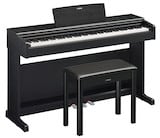 | Yamaha YDP-145 |
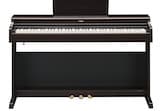 | Yamaha YDP-165 |
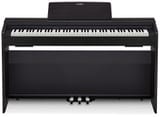 | Casio PX-870 |
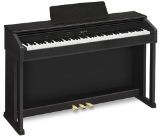 | Casio AP-470 |
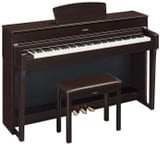 | Yamaha YDP-184 |
Yamaha P-125 vs YDP-143–Let’s Talk Pedals
The pedal setup on the Yamaha P-125 vs. the Yamaha YDP-143 is not the same. The YDP-143 has elegant gold pedals at the bottom of the back wood panel.
The sustain carries out the notes or acts as a digital damper for the digital hammers. The mute deadens the sound. And the sostenuto allows for low notes to be held out while high notes are cut off naturally after being played.
This setup is similar to that on a quality acoustic upright or almost any grand piano.
The Yamaha P-125 has no pedals that come with it —unless the bundle is purchased. This gives it more flexibility with the bundle that offers wood panels for legs and the three pedals. It can also be used with just the sustain pedal, which is an option a lot of players choose to go with.

Below, please check out some of the best-selling digital pianos online, and see how they compare to the pianos we discuss in today’s article.
| BEST SELLERS |
|---|
| 1) Casio PX-770 |
| 2) Yamaha YDP-145 |
| 3) Roland RP-701 |
| 4) Yamaha YDP-165 |
| 5) Casio PX-870 |
Sound Quality
When I first played the Yamaha YDP-143, I was very impressed by its sound. It sounded authentic. And that’s exactly what you’re looking for when you buy a digital piano.
After playing a chord, it felt rich, deep, and full. It had a presence that made playing it feel natural.
The Yamaha P-125 was a bit of a different story, as I played some blues—some major dominant seventh chords under a blues scale up top. First, let’s discuss the positive—the high single notes sounded good. They were brighter and sharper in sound in comparison to that of the Yamaha YDP-143.
The chords, however, did not sound as deep (according to, at the very least, it being in direct competition with the YDP-143. I liked the high single notes, but the chords sounded as if I was playing a lesser or cheaper piano.
The tone controls on these instruments are a bit different, as well. There is a three way variation selector on the Yamaha P-125 that allows for some changes. When I changed the piano setting on the Yamaha P-125, it sounded closer to the Yamaha YDP-143’s grand sound, but still was not quite as good.
Sound Sample Controls
One advantage to owning a digital piano over an acoustic one is that there are different tones or different instrument sound samples that can be selected with the push of a button.
The Yamaha P-125 has three variation banks that provide different selections of a certain sound. The red LED light was easy to see and the buttons did not feel cheap. If someone was using the Yamaha P-125 for preforming purposes they would have an easy time accessing any sounds from the keyboard by toggling the sound and using the three way variation control.
Each of the variations on the Yamaha P-125 is labeled 1, 2, and 3 right on the top of the panel.
The Yamaha YDP-143, by contrast, is a bit more confusing. On the right and left edges of the YDP-143 are controls. On the right hand side there are controls or the master volume and power. These are laid out nicely and are intuitive.
On the other side is where the confusion began. There was a button labeled sound and samples. A button labeled R and one labeled L. There was also a button labeled voice and metronome. If I had held down the voice button and pressed a key on the left side of the keyboard, I would hear I quiet beep notifying me that I had changed a voice.
The thing was, however, that I was not sure what voice it was going to be. Using the owner’s manual, one could determine what voice that would be selected surely but there is just something about labeling the sound samples on the keyboard.
This makes the 143 a bit less desirable for performing because it is harder to pull up the correct sound as easily. Both keyboards could be connected to USB into a computer’s USB port for uses such as recording.
Neither one of these keyboards features a MIDI in or out for connectivity. Uses of the connectivity could be in conjunction with Finale or Sibelius computer programs. It allows for the plotting of notes on the digital music score on the computer. This feature for both of the keyboards also fulfills a good purpose for those learning to play. Tools used for teaching, like Youscian, where note and skills show up on the screen to be practiced, could be applied using this keyboards USB connectivity. When the notes appear on the screen during virtual lessons, the keys pressed correspond and are registered.
Looks and Build Quality
With both of these keyboards being built by the same company you would expect them to have similar build quality and this is mostly true. Both feel like a quality instruments that will last for many years.
Down the road these keyboard will not require any replacement unless someone simply wants to own newer technology. Physically, these keyboards will last. The look of the Yamaha P-125 is sleek. The design looks like it is no frills and has a great layout of buttons speakers and connections. The volume control is a slider that moves left and right.
It moves right to increase the volume and left to bring I down. The volume control on the Yamaha YDP-143 is better to dialing in sound levels. Instead of having a volume that slides it has one that turns. It offers a bit more resistance than the slider and just feels that it is built better.
The material that the Yamaha P-125 is made of is not a metal, rather a hard plastic that feels pretty solid. It seems like I could get thrown around and the casing would keep it in tact.
Both keyboards have a red felt strip across the top of the action. For looks this is a plus and it also helps give the keyboard actions a better feel. The Yamaha YDP-143 has a laminated wood stain finish that seems more fragile.
For looks, the Yamaha YDP-143 would fit better in a home with other mahogany of mid to dark color wooden color furniture. The wood needs more cleaning and is more prone to scratches than the Yamaha P-125. Buying a case for the Yamaha P-125 seems like more of a possibility where you would have a harder time trying to fit the Yamaha YDP-143 inside a case—even the cable was flexible.
Cost
The prices of these keyboards are not the same. The Yamaha P-125 is much lower priced than the Yamaha YDP-143.
By going to Guitar Center or Kraft Music or Amazon online, I was able to find the prices for both of these instruments. The Yamaha P-125 comes in at roughly $599.99 new. The price of the Yamaha YDP-143 comes in at $1099.99 and has two options. It is available in dark rosewood or black walnut. The casing is a big factor in price. It costs a lot less to build the plastic than the wood grain. Allowing for color choice can also be a factor in the cost. It cost more to run two colors of polished wood than just one plastic type casing. There most likely is a cost associated with have a better piano sound.
While playing a classical piece I could exude more feeling and expression through the more expensive keyboard. The extra cost compensates for the ability to draw a more natural sounding instrument.
What comes with or does not come with has an effect on the price. The Yamaha YDP-143 comes with a stand which is of high quality. They are legs with paneling and the back panel is included. Pairing the keyboard from a dealer with replacement plans that the dealer offers is another option one can partake in when buying the instruments.
This added cost can definitely be worth it because repairs on these types of instruments are expensive. Some replacement plans offer even accidental damage protection which provides an added peace of mind.
Speakers
The speaker placements on the keyboards are different and the Yamaha YDP-143 has higher quality speakers that do cost more to make. They are placed on the back of the keyboard and if the keyboard is facing against a wall then they are fully concealed.
According to the Guitar Center page, the Yamaha YDP-143 has four speakers built in. The Yamaha P-125 is said to have only two speakers. This is certainly at least part of the reason for the higher price and better sound of the Yamaha YDP-143.
The speakers on the Yamaha P-125 are found on the top and top back of the instrument. They appear to be smaller and this could provide less bass response among other qualities. Both keyboards have the ability to get loud in a typical home.
They could easily provide for enough volume to be heard in a crowded house party. Connecting to an amp or PA is an absolute must even for a small stage. An ideal amp choice would be almost any Roland offerings. The bigger size amp chosen for the keyboard the bigger room it will fill.
Another thing to consider is how many band members one is playing with and what style of music is being played. If the band features loud distorted guitars then go for at least an 120 watt version of the amp if not more.
Also, if you live with other people, don’t forget to buy a pair of headphones so you don’t wake anyone up with your piano practicing!
Yamaha YDP-143 Pros/Cons
- Pros
- Very Realistic Piano Sound
- Great Wood Finish/Impressive Looks
- Great Feel/Solid Action
- USB connectivity
- 4 Speaker system fills the room
- 3 pedals (included) feel and look perfect
- Can layer two sounds
- Cons
- Not incredibly portable
- Confusing sample section controls
- Confusing button layout for other controls as well except for power and volume controls
- Two headphone outs could be used for an amp but not as ideal as a line out
Yamaha P-125 Pros/Cons
- Pros
- Light and easy to move/ solid portability
- USB connectivity
- Great sounds for organ and up piano notes
- Line out port dedicated for an amp
- Great price/ lots of bang for your buck
- Cons
- Only two speakers that do not provide a good bass response
- Does not come with any pedals unless a bundle is purchased
- Piano samples are a bit sterile
- Action is not as realistic feeling as the Yamaha YDP-143
If you enjoyed this article, we’d love for you to “like” our Digital Piano Review Guide Facebook page!
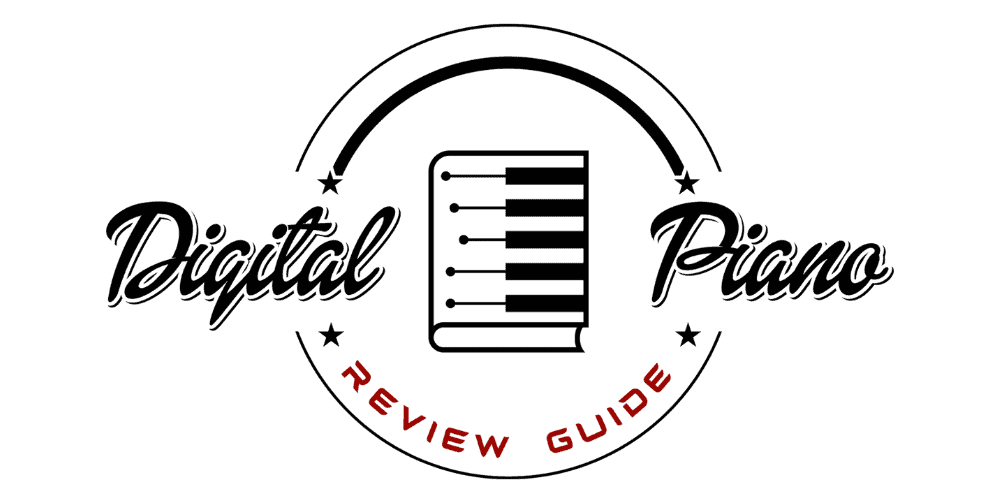




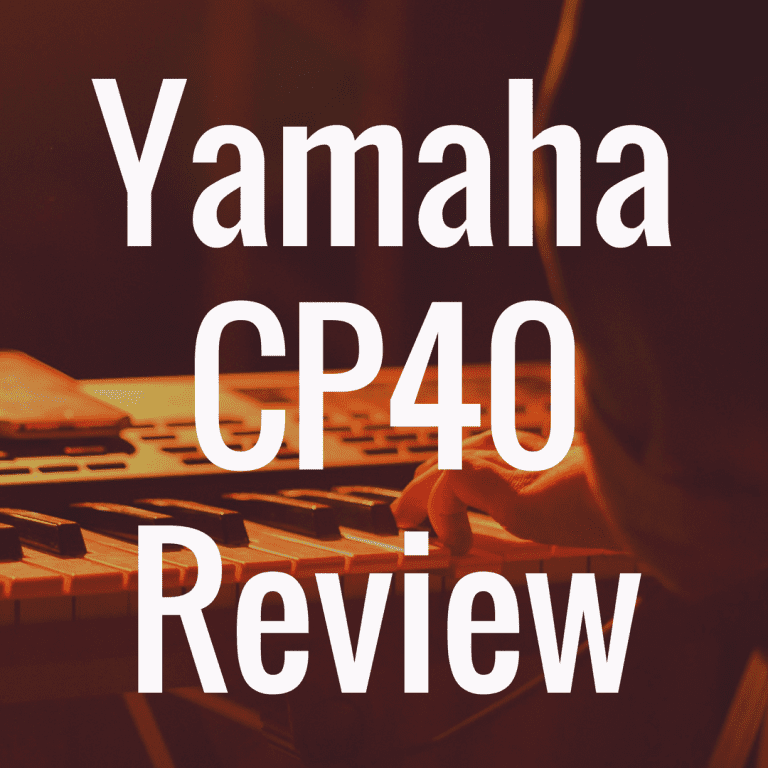

5